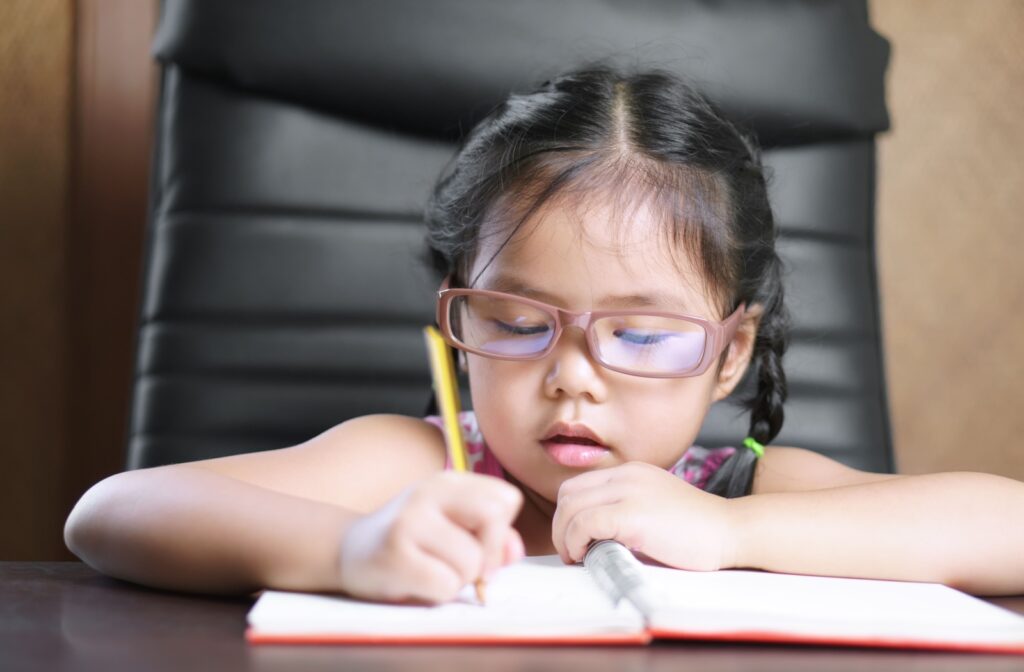As a parent, you know how important clear vision can be. For your child, vision is closely linked to almost every part of your child’s day, and their academic performance is no exception! But when a child starts to struggle in school, their vision is rarely the first place we look—even though it’s often contributing to the problem. So what could be causing your child’s vision problems?
There are 5 key vision problems that can affect your child’s academic success:
- Myopia
- Strabismus
- Amblyopia
- Binocular vision dysfunction
1. Myopia
Myopia, more commonly known as nearsightedness, is a type of refractive error. This condition causes the eye to elongate, changing how your eyes refract light.
This typically develops in early school age and worsens over the years. Eventually, myopia stabilizes around early adulthood. Once the eye begins to elongate, your child may start to experience:
- Blurry vision when looking at distant objects
- Squinting to see more clearly
- Difficulty reading the whiteboard or chalkboard at school
- Sitting too close to the TV or holding books very close to the face
- Complaints of headaches or eye strain
If you notice your child is struggling to see things clearly past a few feet, they might be dealing with myopia. Fortunately, your optometrist can help!
During a regular children’s eye exam, your optometrist can determine your child’s unique prescription to find the right type of eyeglasses or contact lenses for them. Then, they can talk with you about myopia control to preserve your child’s future vision.
2. Strabismus
Inside your eyes, you have tiny muscles that help you aim. They’re responsible for making sure your eyes work together properly to coordinate their movements; this lets you focus on objects to give you vision and depth perception. When your eyes and brain work properly together, the eyes align and communicate to work as one functioning unit.
However, what if there’s a problem with this system? What if the muscles aren’t balanced properly, or if there’s a problem with how your eyes communicate? This results in the eyes struggling to properly work together, and they’ll aim in slightly different directions.
When this occurs, it’s called strabismus or crossed eyes. This makes it difficult for the brain to process visual information; instead of receiving one unified image, it’s being sent improper information. Strabismus often causes:
- Misaligned eyes, pointing in different directions
- Double vision
- Difficulty with depth perception
- Closing or covering one eye to see better
- Tilting the head to try and see more clearly
If you notice that your child has the appearance of crossed eyes, constantly tilts their head, or clearly favors one eye, talk to your optometrist to discuss solutions. With strabismus, early intervention can help your child re-train their brain and eyes to work properly and restore their clear vision.
3. Amblyopia
Your child’s visual system slowly develops over the years. They’ll naturally learn how to see and interpret things around them as their eyes coordinate in unison.
However, sometimes the eyes don’t develop at the same speed. There may be a point where one of your child’s eyes is stronger than the other. Unfortunately, rather than making accommodations, the brain often starts ignoring the weaker eye to favor the stronger.
This is amblyopia, often referred to as “lazy eye.” While the stronger eye can easily be controlled by the brain, the weaker eye may start to wander. The brain ignores most, or all, of the visual information from the weaker eye. If left untreated, this can cause permanent damage to one or both eyes.
Amblyopia often causes:
- One eye that wanders inward or outward
- Poor depth perception
- Squinting or shutting one eye
- Head tilting
- An eye that doesn’t seem to move in sync with the other
Early detection and treatment are crucial in managing amblyopia. Treatment usually aims to re-train the brain to use the weaker eye and encourage healthy development. If caught soon enough, amblyopia can easily be treated with the help of an experienced optometrist.
4. Binocular Vision Dysfunction
To give you the gift of sight, your eyes are constantly coordinating. Because they don’t see the world from the same angle, they send 2 simultaneous images through the optic nerve. This information is combined together to create a single image.
When this works, you’re able to clearly determine depth perception, and control your eyes to look where you need to maintain your clear vision. This visual skill is called binocular vision.
However, this skill doesn’t come easy to everybody. Sometimes, the eyes aren’t able to work seamlessly as a cohesive unit. This condition, called binocular vision dysfunction, can cause:
- Frequent headaches or eye strain
- Double vision or shadowed images
- Difficulty concentrating on near tasks, such as reading or homework
- Skipping lines or rereading lines unintentionally
- Complaints of dizziness or nausea during visual tasks
If you suspect your child is struggling with binocular vision, you should visit your optometrist as soon as you can. Binocular vision dysfunction can be treated effectively through vision therapy to give your child a better chance of succeeding academically.
Building Your Child’s Future—Together
Clear vision is a critical part of your child’s academic success. That’s why it’s so crucial to keep an eye out for signs that something’s wrong.
Here at Fontana Optometric Group, we can help. Whether your child is dealing with myopia, strabismus, or any other eye condition, we can find the cause of their vision problems and determine the right type of treatment. Book an appointment with us, and let’s build your child’s future—together.


